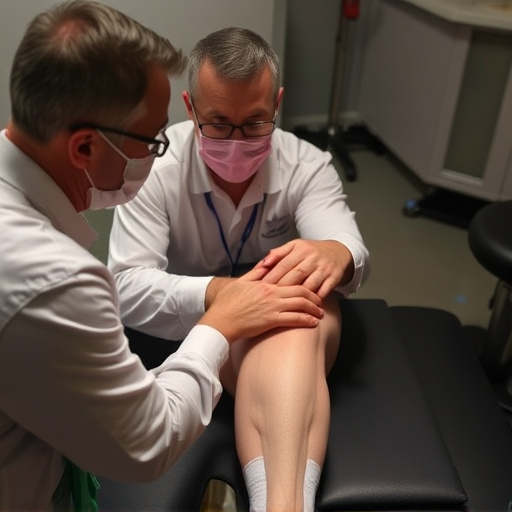Repetitive Strain Injury (RSI) is a condition affecting muscles, tendons, and nerves from repetitive tasks or static postures, causing pain, tingling, numbness, weakness, and fatigue. Treatment involves RICE therapy, physical therapy, ergonomic changes, chiropractic care, and medical interventions. Prevention includes regular breaks, workspace adjustments, exercises, good posture, and low-impact activities; consulting specialists ensures tailored recovery plans.
Repetitive Strain Injury (RSI) is a common yet often misunderstood condition, affecting millions worldwide. Caused by prolonged repetitive tasks or improper posture, RSI symptoms range from discomfort to severe pain. This article guides you through the entire process of RSI treatment, offering insights into understanding and managing this injury effectively. From initial diagnosis to long-term prevention strategies, discover proven approaches for relief and recovery.
- Understanding Repetitive Strain Injury (RSI): Causes and Symptoms
- Treatment Approaches for RSI Relief and Recovery
- Managing and Preventing RSI: Long-Term Strategies and Tips
Understanding Repetitive Strain Injury (RSI): Causes and Symptoms

Repetitive Strain Injury (RSI) is a common condition affecting muscles, tendons, and nerves due to repetitive tasks or prolonged static positions. It’s important to understand that RSI isn’t just about back pain relief; it involves a range of symptoms across various parts of the body, especially in areas like the arms, hands, neck, and upper back. Causes include repetitive motions, such as typing on a keyboard or using a mouse for extended periods, as well as static postures like holding a phone between your ear and shoulder for long conversations.
Symptoms can vary but often include pain, tingling, numbness, weakness, and fatigue in the affected areas. For example, carpal tunnel syndrome is a type of RSI that leads to numbness and pain in the hands and fingers. Soft tissue injuries, like tendinitis or trigger points, are also common with RSI. Recognizing these signs early is crucial for effective treatment, which typically involves a combination of rest, physical therapy, ergonomic adjustments, and, in severe cases, medical interventions aimed at managing pain and promoting healing.
Treatment Approaches for RSI Relief and Recovery

The treatment for Repetitive Strain Injury (RSI) is multifaceted and aimed at alleviating symptoms and promoting recovery. One common approach involves a combination of rest, ice, compression, and elevation, known as RICE therapy, which helps reduce inflammation and pain in the affected area. Physical therapy plays a significant role, focusing on exercises to strengthen muscles, improve flexibility, and restore normal joint function. This can include stretching, strengthening activities, and specialized techniques like ultrasound or electric stimulation to aid healing.
Chiropractic treatment is another effective method for RSI relief, particularly for musculoskeletal injuries affecting the neck and upper limbs. Adjustments made by a chiropractor help realign the joints, reducing pressure on nerves and promoting better blood flow to the affected areas. Additionally, ergonomic assessments and adjustments to work stations can prevent further strain, providing long-term neck pain relief and improving overall posture.
Managing and Preventing RSI: Long-Term Strategies and Tips

Managing and preventing repetitive strain injury (RSI) involves a combination of short-term care and long-term strategies. After receiving initial treatment for RSI symptoms, like rest, ice, compression, and elevation (RICE), it’s crucial to implement sustained preventive measures. Regular breaks during work or activity sessions can significantly reduce strain on muscles and tendons. Ergonomic adjustments at your workspace or workstation are also essential; this includes using supportive furniture, adjusting computer screen placement, and ensuring proper posture while typing or performing repetitive tasks.
Beyond these, incorporating exercises focused on strengthening and stretching affected areas can aid in recovery and deter future RSI incidents. Maintaining good posture not only alleviates existing neck pain or sciatica but also prevents its recurrence. Regularly engaging in low-impact activities like walking or yoga can enhance overall body flexibility and resilience. Additionally, consulting with a personal injury chiropractic specialist or physiotherapist for tailored exercises and advice is beneficial; they can offer guidance on when to resume regular activities, ensuring gradual return to routine without exacerbating RSI.
Repetitive strain injury (RSI) is a common yet debilitating condition that can significantly impact daily life. Understanding the causes and symptoms is the first step towards effective treatment. Various treatment approaches, including rest, physical therapy, medication, and ergonomic modifications, offer relief and aid in recovery. Additionally, implementing long-term strategies for managing and preventing RSI is essential to avoid recurring episodes. By combining these treatments and preventive measures, individuals can effectively manage their RSI and regain control of their daily activities.














